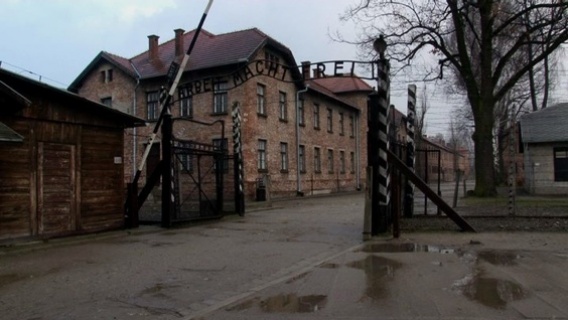
The gate to the main camp at Auschwitz, through which the sick prisoners marched.
Exactly 70 years ago tomorrow, on 28 July 1941, an event of great tragedy and great significance took place. The very first Auschwitz prisoners were selected to be gassed. But in a piece of history which symbolizes the complex history of the camp, these prisoners were not selected because they were Jews, and they were not murdered in Auschwitz, but transported back to Germany to be killed.
What happened in Auschwitz 70 years ago tomorrow was that the so-called ‘adult euthanasia scheme’ was implemented in the camp. In an action known as 14f13, around 500 sick prisoners – some volunteers, some selected by the Nazis – were marched out of the camp and put on a train to Sonnenstein near Danzig. They had been told that they were being sent West to receive medical treatment and be healed. But at Sonnenstein they were murdered in a mental hospital which contained gas chambers designed to look like shower rooms.
We rightly remember the enormous number of Jews who died at Auschwitz – around one million of the one million, one hundred thousand people who were sent to Auschwitz and then murdered were Jewish. But less well remembered are the others who suffered at the camp before the mass arrival of Jews early in 1942.
One Polish political prisoner, Kazimierz Smolen, watched as the sick left Auschwitz 70 years ago. ‘They were all worn out,’ he says. ‘There were no healthy people. It was a march of spectres. At the end of the line were nurses carrying people on stretchers. It was macabre. No one yelled at them or laughed. The sick people were pleased, saying ‘Let my wife and children know about me’.’
All of those sick prisoners who left Auschwitz on 28 July 1941 were murdered by the Nazis.
 Twitter
Twitter






Your blog is rich with content and very informative. Your readers may also enjoy my book, The Bridge of Deaths.
On August 15th, 1939 an English passenger plane from British Airways Ltd. Crashed in Danish waters between the towns of Nykobing/Falster and Vordingborg. There were five casualties reported and one survivor. Just two weeks before Hitler invaded Poland with the world at the brink of war the manner in which this incident was investigated left much open to doubt. The jurisdiction battle between the two towns and the newly formed Danish secret police, created an atmosphere of intrigue and distrust.
In the winter of 2009-2010 a young executive, Bill is promoted and transferred to London for a major International firm. He has struggled for the better part of his life with nightmares and phobias, which only seem to worsen in London. As he seeks the help of a therapist he accepts that his issues may well be related to a ‘past-life trauma’.
Through love, curiosity, archives and the information superhighway of the 21st century Bill travels through knowledge and time to uncover the story of the 1939 plane crash.
The Bridge of Deaths is a love story and a mystery. Fictional characters travel through the world of past life regressions and information acquired from psychics as well as archives and historical sources to solve “One of those mysteries that never get solved” is based on true events and real people, it is the culmination of 18 years of sifting through sources in Denmark, England and the United States, it finds a way to help the reader feel that he /she is also sifting through data and forming their own conclusions.
The journey takes the reader to well known and little known events leading up to the Second World War, both in Europe and America. The journey also takes the reader to the possibility of finding oneself in this lifetime by exploring past lives.
Best,
Catalina Egan
http://thebridgeofdeaths.tumblr.com/
Well, catalina, it sounds like a good read – although I struggle with books that mix fact with fiction. Where does one begin and the other end?